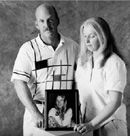Praise for DES Stories
 Highly recommended for all collections.
Highly recommended for all collections.
—The Library Journal
It is impossible not to be moved, sometimes to tears, sometimes to cheers, by DES Stories.
—Congresswoman Louise Slaughter, United States Congress
Future generations are indebted to the author and those in this book for sharing their experience.
—Theo Colborn, Ph.D., co-author Our Stolen Future
This is the book we've been waiting for; to tell the human story.
—Marlies Koester, health educator, DES Centrum The Netherlands
DES Stories puts DES where it should be; in the middle of public and private discourse about hormones, technology, and our risk for chemical exposure.
—John McLachlan, Ph.D., Director, Center Bioenvironmental Research, Tulane and Xavier Universities
Margaret Braun has compiled an important contribution to the literature and understanding of DES exposure.
—Arthur L. Herbst, M.D., Chair Dept OB GYN, University of Chicago.
DES Stories brings home the DES tragedy to me in a way that even twenty years of scientific study could not.
—Shanna Swan, Ph.D., epidemiologist, University of Missouri
 Nancy Stuart's portraits capture the moment of human honesty when men and women speak their truth.
Nancy Stuart's portraits capture the moment of human honesty when men and women speak their truth.
—Therese Mulligan, Curator of Photography, International Museum of Photography, George Eastman House
DES Stories tells the story of one of the most devastating corporate and medical mistakes of our time. Woven in these stories are important lessons about coping, survival, life, and death.
—Susan P. Helmrich, Ph.D., co-founder and co-chair DES Cancer Network
DES Stories puts a human face on the DES issue that cannot be found in countless medical statistics.
—Elizabeth Hatch, Ph.D. Boston University School of Public Health.
I encourage as many individuals as possible to read DES Stories closely to prevent similar tragedies in the future.
—Raymond Kaufman, M.D. Professor, Department Obstetrics Gynecology, Baylor College of Medicine
In DES Stories the survivors reveal with clarity the critical lessons the DES ordeal has for us all.
—Chellis Glendinning, Ph.D., author When Technology Wounds:Human Consequences of Progress
DES Stories bears witness to a major global medical event and gives meaning, hope, and healing to people everywhere touched by DES.
—Roberta Apfel, M.D., M.P.H., Clinical Associate Professor of Psychiatry, Harvard Medical School. Co-author To Do No Harm: DES and the Dilemmas of Modern Medicine.
Nancy Stuart's photographs reveal the emotional ties within family relationships in this complex story.
—Paul Caponigro, photographer. Author Landscape, and Meditations in Light
DES Stories gives voice to a public health tragedy that while enormous has remained relatively quiet. These eloquent stories have meaning for us all.
—Nora Cody, Executive Director, DES Action
 From 1938 to 1971, physicians prescribed diethylstilbestrol (DES) to prevent miscarriage and promote the birth of healthy infants. It was also used as a morning-after pill, a lactation suppressor, and a treatment for acne and some cancers. Ranchers added it to livestock feed. By 1970, a rare, sometimes fatal vaginal cancer began to appear in teenage girls, and research linked it to the DES that their mothers took. Scientists also discovered that the drug caused autoimmune disease, fertility problems, and urogenital deformities in exposed sons and daughters. Braun, a DES daughter, and Stuart, an award-winning photographer, show us the consequences of DES exposure by bringing us portraits and stories of 40 people affected by the drug. Mothers, sons, daughters, and spouses speak frankly about their struggles with illness, infertility, and guilt. Unlike traditional women's health or environmental studies books, this volume, appearing on the 30th anniversary of the discovery of the DES-cancer link, serves as both a cautionary tale and a monument to the resilience of the affected. Highly recommended for all collections. Barbara M. Bibel, Oakland P.L., CA Copyright 2001 Cahners Business Information, Inc.
From 1938 to 1971, physicians prescribed diethylstilbestrol (DES) to prevent miscarriage and promote the birth of healthy infants. It was also used as a morning-after pill, a lactation suppressor, and a treatment for acne and some cancers. Ranchers added it to livestock feed. By 1970, a rare, sometimes fatal vaginal cancer began to appear in teenage girls, and research linked it to the DES that their mothers took. Scientists also discovered that the drug caused autoimmune disease, fertility problems, and urogenital deformities in exposed sons and daughters. Braun, a DES daughter, and Stuart, an award-winning photographer, show us the consequences of DES exposure by bringing us portraits and stories of 40 people affected by the drug. Mothers, sons, daughters, and spouses speak frankly about their struggles with illness, infertility, and guilt. Unlike traditional women's health or environmental studies books, this volume, appearing on the 30th anniversary of the discovery of the DES-cancer link, serves as both a cautionary tale and a monument to the resilience of the affected. Highly recommended for all collections. Barbara M. Bibel, Oakland P.L., CA Copyright 2001 Cahners Business Information, Inc.
-From Library Journal 2001
